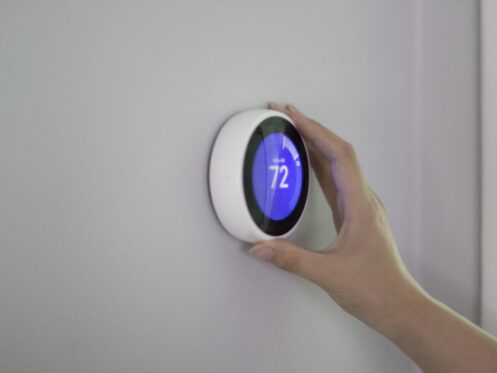Thermostats are a critical part of your home’s HVAC system. Whether you’re trying to beat the summer heat or stay warm during winter’s chill, you’ll be reaching for the thermostat to fiddle with the numbers.
Choosing a thermostat, however, can be a bigger task than it seems. There are many different options out there, so you’ll need to be smart about your choice if you want to live in comfort while also saving money and energy. Other things to consider include customization options, environmental safety, and the compatibility of your chosen thermostat with your property.
Consider this your guide to both understanding and buying the best types of thermostats for your home and its HVAC system.
A Basic Overview of Thermostats
On an operational level, there are two different types of thermostats: mechanical and digital.
On a consumer level, there can be many different types of thermostats, including programmable, non-programmable, and Wi-Fi controlled. You might also see them categorized with labels like electric, electromechanical, and smart. Some of these categories can overlap.
Features of thermostats can range from energy reports to automatic adjustments based on weather forecasts. Especially in modern units, tech and customization options can be immense. Older units tend to have less flexibility.
Not every type of thermostat is compatible with every home. Your HVAC system needs to have the right kind of voltage, wiring, and overall infrastructure for your thermostat. If you aren’t sure which type of thermostats are suitable for your HVAC system, talk to a professional.
How Thermostats Work
What does a thermostat actually do? What’s happening when you adjust the dial?
While the science can get quite complex, the basic explanation is that your thermostat controls an internal switch or sensor that’s connected to an electrical circuit in your HVAC system. Their mechanisms can differ depending on the type of thermostat that you buy.
In mechanical thermostats, for example, the switch is made of metal. Specifically, it’s two different types of metal that make up a “bimetallic strip.” This strip expands as it comes into contact with hot air and contracts as it gets cooler, operating under the principle of thermal expansion.
The expanding and contracting of the strip is what triggers the electrical circuit connected to your home’s HVAC system. In other words, it’s the green light for temperature adjustment. This is why you can’t instantly make a room hotter or colder: You have to wait for the bimetallic strip to change and the electrical circuit to register that.
Digital thermostats work in a similar fashion, but they use sensors and resistors rather than bimetallic strips. Ultimately, however, they still trigger a response in the electrical circuit.
Another type of thermostat that you might encounter is a mercury thermostat. They’ve been banned in the U.S. because of environmental concerns, but you can still find them in older homes. It isn’t illegal to have them, but you’re encouraged to upgrade not only for safety reasons but because mercury thermostats are quite limited in their operation. Both mechanical and digital thermostats have much better technology, and temperature-wise, they can provide more accurate heating and cooling capabilities.
The Pros and Cons of Mechanical Thermostats
Mechanical thermostats operate on older technology than digital ones, and their operation is more manual. You have to physically turn a dial to adjust their temperature.
Another drawback of mechanical thermostats is that they aren’t entirely accurate. Generally speaking, they operate within a range of the set temperature rather than the exact number. For example, if you set your mechanical thermostat to 70°F, you might get an output of anywhere from 68°F to 73°F.
The advantage of owning a mechanical thermostat is that it’s cheaper, especially if it’s already in your home. Digital thermostats can be expensive to install with a high upfront cost. Mechanical thermostats also tend to be more stable in terms of power, so if you live somewhere with recurrent spikes or surges in electricity, they can be the more reliable option.
Last but not least, mechanical thermostats are easier to use. They have a simple, hands-on dial rather than dozens of different tech-enabled customization options that you have to adjust. They might be the preferable choice to anyone who can’t or doesn’t want to own a smartphone.
The Pros and Cons of Digital Thermostats
Digital thermostats are the modern option. They don’t contain mercury or metal like older models do, and they don’t always require you to be physically present to change their settings. With smart thermostats, for example, you can access their controls through any device with an Internet connection, including phones, laptops, and tablets. You can adjust the temperature of your home while you’re still at work, ensuring that your living room is nice and toasty by the time that you arrive.
Another benefit of digital thermostats is that they’re more accurate than their mechanical counterparts. While mechanical models operate within a range around your desired temperature, digital ones can be tweaked to specific temperatures.
Additionally, many digital thermostats are programmable. They can remember the settings that you input for ease of use later. Some smartphone models are even capable of predictive behavior that will learn your habits and routines and adjust themselves accordingly.
The disadvantage of digital thermostats is that they’re more expensive to install. You can earn back this investment through their long-term energy savings, but that will take time. If you’re on a budget, digital thermostats might not be an option for you, especially if their installation would require more modern upgrades to your HVAC system.
Another thing to consider is their usability. Some of the sleekest, most futuristic digital thermostats come with a dizzying amount of user options. You might have to possess a certain amount of tech-savvy to navigate them.
Special Features in Thermostats
This can be the most fun part of buying a new thermostat. What functions and features do you want? Just how much can you customize your new gadget?
The answer is “a lot.” Modern thermostats are available with all sorts of special features, especially when they’re smartphone enabled. However, even a non-smart programmable thermostat can be an upgrade from a manual one.
Here are just a few features that you might see in contemporary thermostats:
- Date and time readings
- Internet connectivity
- Energy usage reports
- Indoor air quality control
- Programmable settings, including geofencing
- Automatic adjustments based on weather conditions or forecasts
- Integration with other smart features such as lights and locks
- Alerts when issues are detected
The special features available to you will depend entirely on the brand and model of the thermostat that you buy. There’s no such thing as a one-size-fits-all thermostat. You’ll have to make a choice as a homeowner about which features matter most to you.
Choosing the Best Thermostat for Your Home
Ultimately, it’s up to you to decide which kind of thermostat will be comfortable, compatible, and cost-efficient for your home. To learn more about your options, contact us at Protek Roofing, Heating, Air & Solar in Tampa. We can install and repair both heating and cooling systems. We also offer services related to solar power, indoor air quality, and roofing.




